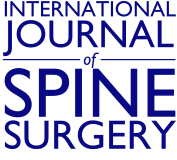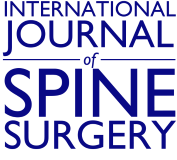Abstract
Introduction Advanced intraoperative neuromonitoring (IONM) is used to attenuate postoperative complications and side effects of extreme lateral interbody fusion (XLIF). Specific factors relate to the presence of postoperative injury are not well understood. This study aims to identify intraoperative variables with correlations to new postoperative anterior thigh/groin sensory changes.
Methods Twenty-nine patients with various degenerative lumbar conditions were treated with XLIF at a single institution. Mean age was 59 years, 69% were female, and 21% had undergone previous lumbar surgery. A total of 47 levels (mean 1.6, range 1-3) were treated with XLIF. Supplemental pedicle screw and rod fixation was used in 24 patients (83%). Dynamically-evoked electromyography was used in all cases. Analysis of baseline demographic and treatment variables were performed at a per patient basis (n = 29), whereas analysis of intraoperative variables were performed at a per levels treated basis (n = 47).
Results Within 24 hours postoperative, 10 (34%) patients experienced anterior thigh/groin sensory changes (4 reported pain only, 5 reported pain plus other sensory changes, and 1 paresthesia without pain). Symptom resolution occurred at 1 month postoperative for 4 patients, at 3 months postoperative for 2 patients. At 3 months postoperative, 6 patients had complete symptom resolution, 3 patients had symptom improvements, and 1 patient had no change in perioperative symptoms. Psoas dimension in the lateral-latero direction were significantly smaller for patients with postoperative sensory changes (p = 0.025), and similarly, patients with postoperative sensory changes had a significantly higher ratio of psoas muscle in the anterior-posterior to lateral-latero directions (p = 0.026).
Conclusions In addition to IONM, MRI evaluation of psoas shape, position, and dimension may be of help in preoperative planning of a safe XLIF access and eventually, predict those cases with higher risk of approach-related post-operative events.
- Copyright © 2015 ISASS - This manuscript is generously published free of charge by ISASS, the International Society for the Advancement of Spine Surgery







